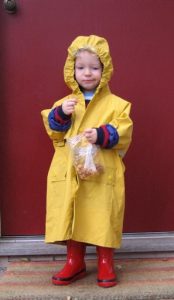One of the most important foundations of ADST is “Computational Thinking“. OK right now, you’re probably wanting to run away. You’re thinking who cares OR it doesn’t apply to me as I teach little folks. Well I’m here to say it does apply to you and everyone else living in this world. Let’s break this down to simpler speak. 
If you haven’t noticed, we’re in the most stormy month of the season – rain, lots of rain, high winds, whipping tree branches, tons of fallen leaves and flooded roads where you least expect them. The bell has just gone for Recess – yes we celebrate “West Coast Recess” so it’s time to get out and experience living in our temperate rain forest. Here goes the scenario as it’s played out in classrooms across our district.
VIEW FROM A STUDENT: You know that you can’t leave the classroom without donning your boots and rain gear. Scramble to the cloakroom, grab your snack from the backpack, stick on a boot and race out! Hold on, you’re pulled back by the teacher for missing items. Back to the cloakroom you go – precious minutes are ticking away. You decide to dump the snack – you’re not starving (you surmise lunch is just around the corner). You spy the soccer ball and pick it up. But your hands are full now and you can’t get on that jacket and boots – another problem! This is not going as planned. New plan…down goes the soccer ball. On goes the jacket, off goes the shoes, on goes the boots (both ones this time and hopefully on the right foot) but perhaps not in that order. Grab the ball, then try again to get past the teacher.  Success! You’re finally outside with the wind at your face and friends waiting to create a new game.
Success! You’re finally outside with the wind at your face and friends waiting to create a new game.
You’ve just experienced “computational thinking“, which involves the following characteristics:
- Decomposition – breaking down the problem into tiny parts (eg. how to get on all the gear you need so you can get outside to play. Goal? Get outside [fast] to play.)
- Pattern recognition – notice patterns in the work or problem or see it from different angles (eg. shoes go off one foot at a time and boots go on one foot at a time; jackets usually go on one arm at a time; Can this be generalized anywhere else?)
- Abstraction – ignore the parts that are irrelevant or unnecessary (eg. your mom made you bring an umbrella – is it really necessary? Do you need to button up that jacket-maybe one will do? Do you really need that snack?)
- Algorithm – create a bunch of steps to solve the problem or set of rules to follow (eg. first, then, next…)
Like “Core Competencies“, which start with ‘notice and name it’, we do the same with ‘computational thinking’.  We attach a name to the thinking process and procedure making them overtly recognizable so we can talk about them. Remember this is not a spelling lesson! Sharing this process with multiple examples goes a long way to including the heart of ADST. If you’re interested in a poster outlining ‘computational thinking’, email us.
We attach a name to the thinking process and procedure making them overtly recognizable so we can talk about them. Remember this is not a spelling lesson! Sharing this process with multiple examples goes a long way to including the heart of ADST. If you’re interested in a poster outlining ‘computational thinking’, email us.
*Oh by the way, you did decide on the snack after all. You stuffed it in your rain jacket pocket.